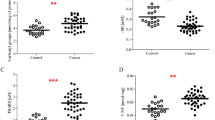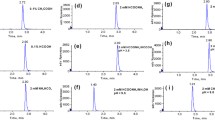Abstract
Purpose
This study aimed to use non-invasive methods to assess and compare the levels of oxidative indices and non-enzymatic antioxidants in breast and colorectal cancer (CRC) patients. Various studies have reported on lipid peroxidation, hydrogen peroxide (H2O2) and ferric-reducing antioxidant power (FRAP) levels in the serum of cancer patients but this is the first report that highlights the significance of urinary-advanced oxidative protein product (AOPP) in cancer patients.
Methods
The levels of advanced oxidative protein product (AOPP), hydrogen peroxide (H2O2), malondialdehyde (MDA) which is a marker for lipid peroxidation and ferric-reducing antioxidant power (FRAP) were measured in urine samples of breast (n = 101) and colorectal cancer (n = 49) patients attending the Oncology Clinic, University Malaya Medical Centre, Kuala Lumpur and were compared with 95 age-matched healthy individuals.
Results
AOPP, H2O2 and MDA levels in the urine were significantly higher in the CRC patients compared to the control subjects and breast cancer patients. In breast cancer patients, only AOPP level was elevated. FRAP level did not differ between breast and colorectal cancer patients but the levels were significantly lower compared to control subjects.
Conclusion
Urinary oxidative indices such as AOPP, H2O2, and MDA as well as FRAP could serve as useful non-invasive oxidative stress markers in colorectal cancer but only AOPP serves as a useful urinary oxidative biomarker in breast cancer.

Similar content being viewed by others
References
Balducci L, Extermann M (1997) Cancer chemotherapy in the older patient: what the medical oncologist needs to know. Cancer 80:1317–1322. doi:10.1002/(SICI)1097-0142(19971001)80:7<1317::AID-CNCR18>3.0.CO;2-A
Banerjee D, Madhusoodanan UK, Nayak S, Jacob J (2003) Urinary hydrogen peroxide: a probable marker of oxidative stress in malignancy. Clin Chim Acta 334:205–209. doi:10.1016/S0009-8981(03)00236-5
Benzie IFF, Strain JJ (1996) The ferric reducing ability of plasma (FRAP) as a measure for “Antioxidant Power”; The FRAP assay. Anal Biochem 239:70–76. doi:10.1006/abio.1996.0292
Gille G, Sigler K (1995) Oxidative stress and living cells. Folia Microbiol (Praha) 40(2):131–152. doi:10.1007/BF02815413
Halliwell B (1994) Free radicals, antioxidants, and human disease: curiosity, cause, or consequence? Lancet 344:721–724. doi:10.1016/S0140-6736(94)92211-X
Kalousova M, SKRHA J, Zima T (2002) Advanced glycation end-products and advanced oxidation protein products in patients with diabetes melitus. Physiol Res 51:597–604
Kang DH (2002) Oxidative stress, DNA damage, and breast cancer. AACN Clin Issues 13(4):540–549. doi:10.1097/00044067-200211000-00007
Lim GCC, Halimah Y (2004) Second Report of the National Cancer Registry. Cancer Incidence in Malaysia 2003. National Cancer Registry, Ministry of Health Malaysia, pp 1–141
Masuda M, Suzuki T, Friesen MD, Ravanat J-L, Cadet J, Pignatelli B et al (2001) Chlorination of guanosine and other nucleosides by hypochlorous acid and myeloperoxidase of activated human neutrophils: catalysis by nicotine and trimethylamine. J Biol Chem 276:40486–40496. doi:10.1074/jbc.M102700200
Punnonen K, Ahotupa M, Asaishi K, Hyoty M, Kudo R, Punnonen R (1993) Antioxidant enzyme activities and oxidative stress in human breast cancer. J Cancer Res Clin Oncol 120:374–377. doi:10.1007/BF01247464
Quintero M, Brennan PA, Thomas GJ, Moncada S (2006) Nitric oxide is a factor in the stabilization of hypoxia-inducible factor-1alpha in cancer: role of free radical formation. Cancer Res 66(2):770–774. doi:10.1158/0008-5472.CAN-05-0333
Ratty AK, Das NP (1986) Lipid peroxidation in the rat brain mitochondria in the presence of ascorbic acid. IRCS Med Sci 14:815–816
Saygili EI, Konukoglu D, Papila C, Akcay T (2003) Levels of plasma vitamin E, vitamin C, TBARS, and cholesterol in male patients with colorectal tumors. Biochemistry (Mosc) 68(3):325–328. doi:10.1023/A:1023010418230
Shioji I (2005) Oxidative stress related diseases and biopyrins. Rinsho Byori 53:155–159
Valko M, Rhodes CJ, Moncol J, Izakovic M, Mazur M (2006) Free radicals, metals and antioxidants in oxidative stress-induced cancer. Chem Biol Interact 160(1):1–40. doi:10.1016/j.cbi.2005.12.009
Witko-Sarsat V, Friedlander M, Capeillere-Blandin C, Nguyen-Khoa T, Nguyen AH, Canterloup S et al (1998) Advanced oxidation protein products as novel mediator of inflammation and monocyte activation in chronic renal failure. J Immunol 161:2524–2532
Wright JG, Boddy AV, Highley M, Fenwick J, McGill A, Calvert AH (2001) Estimation of glomerular filtration rate in cancer patients. Br J Cancer 84:452–459. doi:10.1054/bjoc.2000.1643
Yeh CC, Hou MF, Tsai SM, Lin SK, Hsiao JK, Huang JC et al (2005) Superoxide anion radical, lipid peroxides and antioxidant status in the blood of patients with breast cancer. Clin Chim Acta 361(1–2):104–111. doi:10.1016/j.cccn.2005.05.002
Acknowledgments
This research was supported by the University of Malaya grant (BM27) and IRPA grant awarded by the Ministry of Science, Technology and Environment (IRPA 06-02-02-0580 and 36-02-03-6020).
Author information
Authors and Affiliations
Corresponding author
Rights and permissions
About this article
Cite this article
Chandramathi, S., Suresh, K., Anita, Z.B. et al. Comparative assessment of urinary oxidative indices in breast and colorectal cancer patients. J Cancer Res Clin Oncol 135, 319–323 (2009). https://doi.org/10.1007/s00432-008-0462-7
Received:
Accepted:
Published:
Issue Date:
DOI: https://doi.org/10.1007/s00432-008-0462-7




